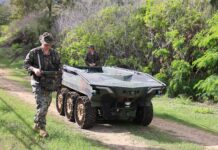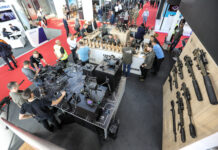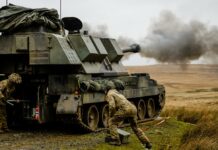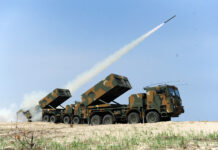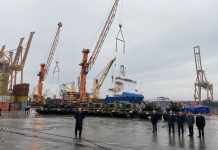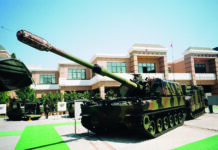The story begins with a small company formed in the midst of a war in the Republic of Korea (ROK) in 1952 and continues to the present day with the company having grown to become one of the most important ROK companies and a global conglomerate in the form of Hanwha. Now Hanwha is poised to add a new capability to its portfolio that could see it acquire a shipbuilding group, making it the owner of one of the major producers of naval and commercial vessels in the ROK.

(Credit: Hanwha)
Before going into an in depth discussion of the evolution of a major ROK defence company, its necessary to delve into the history of the ROK to provide some context of the political, economic and defence/defence industrial challenges that the country has faced. The starting point comes in 1910, when Korea became a colony of Japan. The Japanese colonial administration put most of their focus on industrial and infrastructure development into the north of the country. This was also a response to the fact that there were natural resources in the North of Korea, such as coal, iron ore, magnesite, zinc and gold. In turn this led to the development of cement and chemical factories, electricity generation, industrial enterprises, steel mills, synthetic fibre and textile production and even shipbuilding and ship repair facilities. In contrast, the South of the country, effectively the ROK of today, was primarily an agricultural economy.
After the Japanese surrender in August 1945, Korea was partitioned along the 38th parallel, with the Soviet zone of occupation in the North and the US zone in the South. At this time, it was estimated that 65% of heavy industry was in the North, while the bulk of the population was in the South. The partition of Korea was not supposed to be permanent, however the inability of the Soviet Union, the US and even the UN to agree a path forward towards an independent and reunified Korea, inevitably led to a continuation of the partition. In the North, the Democratic People’s Republic of Korea (DPRK) was formed, with Kim Il-sung as its leader, backed by the Soviet Union, while in the South, the ROK emerged with Syngman Rhee as its leader, backed by the US.
The end result of all of this was conflict, on 25 June 1950, the DPRK’s Korean People’s Army (KPA) invaded the ROK and the Korean War began. The KPA was on the verge of victory until ROK Army (ROKA) resistance and US and international intervention, under the auspices of the UN, turned the tide. This then led to UN forces advancing into the DPRK and heading towards the DPRK northern border with China. The plan was that the UN forces would bring the conflict to a conclusion by the end of 1950, instead the northern advance by UN forces led to Chinese intervention, in the form of the Chinese People’s Volunteers (CPV). The CPV pushed the UN Forces back and a little over a year after the Korean War had started, the conflict was in stalemate in the vicinity of the original border between the DPRK and the ROK. However, the conflict continued until the signing of an armistice on 27 July 1953.
Rebuilding Korea
In the aftermath, the ROK was devastated. Seoul, the ROK capital, had been lost twice and recaptured twice, it does not take much to imagine the level of destruction inflicted on that city. All across the ROK were ruins and destroyed infrastructure, but in the midst of all of this some saw opportunity as the ROK would inevitably have to be rebuilt. Among these was a man by the name of Chong-Hee Kim, who at that time was the manager of Joseon Gunpowder Joint Market, Inc. In 1952 Chong-Hee Kim purchased the Joseon Gunpowder company and renamed it ‘Korea Explosives’. Reconstruction in the ROK created a demand for industrial explosives, and by the end of the 1950s Korea Explosives was in a position to meet domestic demand. Previously, significant quantities of industrial explosives had been imported from Japan.
During the 1960s the Korean government embarked on a policy of state-sponsored industrial development to grow the ROK economy. Tariff barriers were put into place limiting foreign imports, while at the same time creating a situation where ROK companies could use their dominance of the domestic market to allow them to expand into international markets. The ROK government dominated the financial sector, allowing favoured companies to receive financing for expansion, and also provided tax breaks for companies as they grew into new sectors, particularly sectors that the government saw as strategically critical to future economic development.
These were the circumstances the led to the rise of the ‘Chaebol’, a phenomenon particular to the ROK economy. A Chaebol is a family-run conglomerate, consisting of large numbers of diversified affiliates or subsidiaries. The ROK government economic strategy used the Chaebol as the means to drive the growth of the ROK economy. Growth was certainly delivered – from the early 1960s until the late 1980s, the ROK Gross Domestic product grew at a rate of 8% year-on-year! Who were∕are the Chaebol? Well-known names such as Samsung, Hyundai, Lotte Group, LG, Doosan, Hanjin and Hanwha are all Chaebol. All have multiple affiliates, Samsung is said to have 60, LG has 73, Lotte Group has 75 and some Chaebol have over 100 affiliates.
Hanwha presents an excellent example of how Chaebol diversified (the company only adopted the name ‘Hanwha’ in 1992, up until that point it had remained ‘Korea Explosives’). The first expansionary programme in the 1960s saw the company move into construction, then petrochemicals and then the energy sector. In the 1970s, this was followed by further investments in petrochemical concerns, machinery manufacture, hotels and resorts and financial services. Investment and expansion into these business areas continued in the 1980s and there was also investment into the automotive sector.
Years of continuing economic growth for the ROK and seemingly endless expansion for the Chaebol came to a grinding halt due to the Asian Financial Crisis of 1997. The collapse of the Thai baht against the US dollar set off a wave of financial contagion across Asia and this eventually battered the ROK economy. Korean banks had recklessly lent large sums to the Chaebol and other ROK companies, who became heavily indebted. As the ROK currency started to depreciate, the banks became vulnerable, stopped lending and started calling in loans. To halt the crisis the ROK government acted, with the assistance of the IMF, to avoid financial collapse and were successful.
Recovery from the financial crisis forced many Korean companies to restructure to reduce their debt burden and to sell off or otherwise dispose of unprofitable or underperforming subsidiaries. A notable major corporate casualty of the financial crisis and was Daewoo, then the second largest conglomerate in the ROK. Daewoo went bankrupt in 1999 with debts of USD 50 Bn! The ROK government and financial institutions worked to preserve the 20 companies that made up Daewoo, setting some up as independent companies and selling others. The Daewoo companies were active in construction, telecoms, electronics, cars, trucks and buses, as well as other areas. Most significantly they were also a major defence company and shipbuilder in the ROK, these ex-Daewoo assets would eventually come to play a part in the story of Hanwha’s rise as a defence company.
Defence Beginnings
Like many other Chaebol, Hanwha had to reduce debt and restructure after the financial crisis, a task which it managed successfully. By this point the company was starting to be a player in the ROK defence industry. This most visible part of this process was in the form of the K136∕K136A1 Kooryong 130 mm Multiple Rocket Launcher (MRL). The Kooryong was designed by the ROK Agency for Defense Development (ADD) in the 1970s, in response to an ROK military requirement for a counter to the large number of MRL systems fielded by North Korea. Hanwha was tasked by ADD with the manufacture of rockets for the Kooryong system, producing HE, HE-FRAG and extended-range rockets for the original K136 system, and later the improved K136A1 variant. In parallel, Hanwha’s defence involvement grew, ushering in the production of pyrotechnics and propellant charges for conventional artillery.
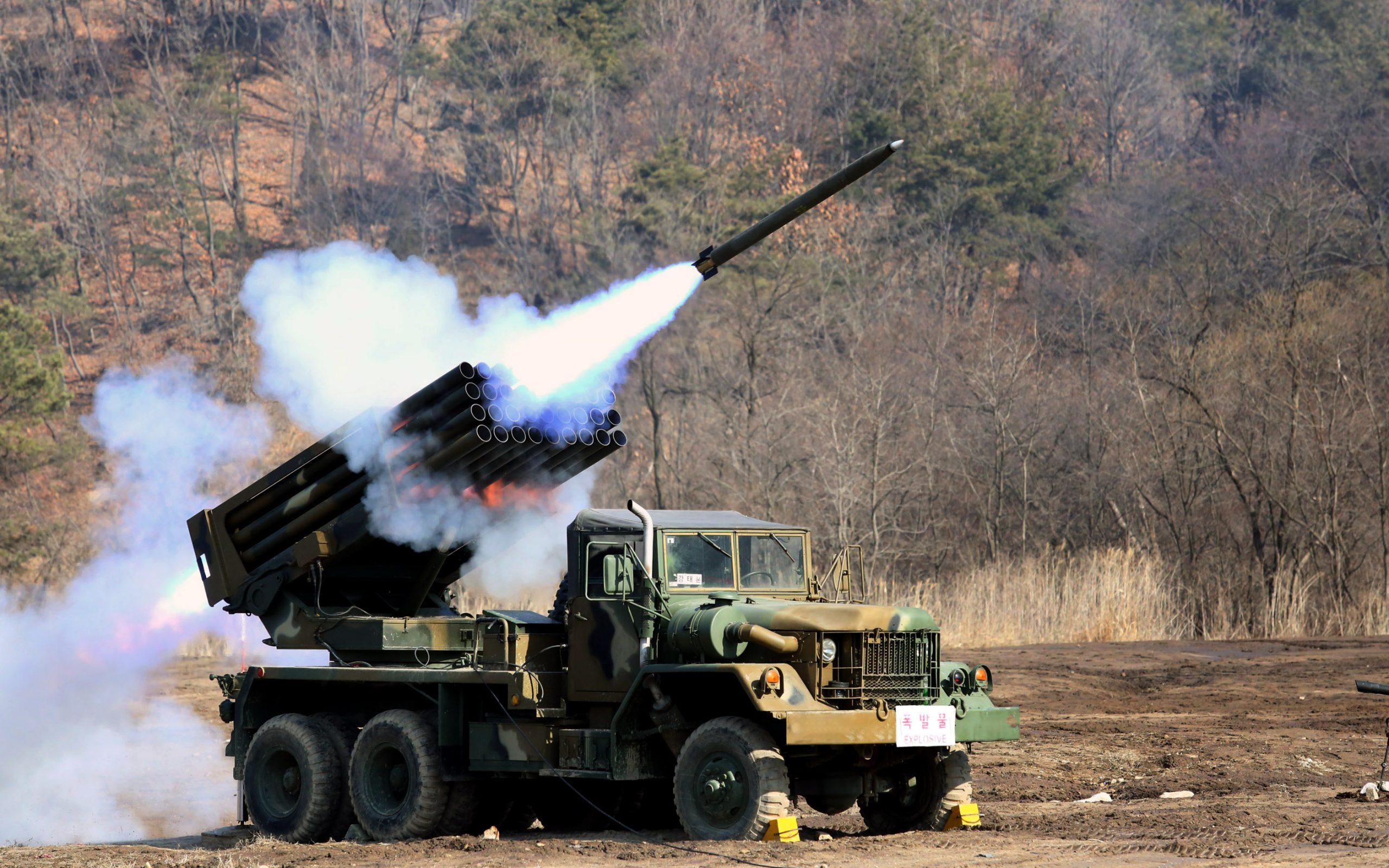
Hanwha was part of the ROK defence ecosystem, but at this point it was not a major player. The leading positions were occupied by Chaebol such as Hyundai, Samsung and Daewoo. However, as previously noted, the Asian Financial Crisis of the late 1990s led to the collapse of Daewoo and substantial reorganisation at the other Chaebol. It also saw new players enter the defence sector through corporate acquisition.
Doosan, a Chaebol that was founded in 1896, had interests in construction equipment and industrial vehicles. They saw synergy with Daewoo Heavy Industries (DHI) and officially acquired the company from the ROK government entity charged with managing the post-bankruptcy assets of Daewoo in early 2005. Post-acquisition, the enlarged Doosan became a major player in the ROK armoured vehicles sector.
In the early 1980s the ROK Army developed a requirement for what they called the “Korean Infantry Fighting Vehicle (KIFV).” The ADD was charged with developing a system to meet the requirement and DHI was selected as the manufacturer. A decision was taken to buy a foreign armoured vehicle design and the resulted in the selection of the Food Machinery Company (FMC) Armoured Infantry Fighting Vehicle (AIFV) design, itself a further development of the M113A1. The AIFV had been purchased by Belgium, the Netherlands and the Philippines and so was a proven design. For the ROK application, modifications were made to the AIFV baseline design to meet local requirements. It should be noted that the AIFV design also provided the basis for the FNSS ACV vehicle family in Turkey.

By 1984, DHI’s infrastructure for the manufacture of the KIFV was ready and first deliveries of the K200 KIFV followed thereafter. The K200 then provided the basis for a complete family of vehicles: two types of mortar carrier, recovery vehicle, NBC reconnaissance, command post and an anti-aircraft variant mounting an M167A1 20 mm Vulcan cannon. Then an upgraded version of the vehicle, the K200A1, featuring improved automotive systems, entered production. In turn this spawned variants such as mortar carriers, recovery vehicles and air defence vehicles.
The K200 platform also provided the basis for a far more impressive mobile air defence capability in the form of the K30 Biho system. This was equipped with twin 30 mm KKCB automatic cannons from S&T Dynamics, a surveillance and tracking radar and an optoelectronic sight. The capabilities of the system were enhanced by the installation of the indigenous Shingung very short range air defence (VSHORAD) system, developed under the KP-SAM programme. Biho developments include a variant mounted on a wheeled platform and more recently Hanwha developed the Biho II, offered on either an 8×8 wheeled or tracked platform. The K200 also provided the basis for the K-SAM Chunma mobile short range air defence (SHORAD) system based on the Thales Crotale NG, which was further developed by the Samsung Thales joint venture to meet ROK requirements.
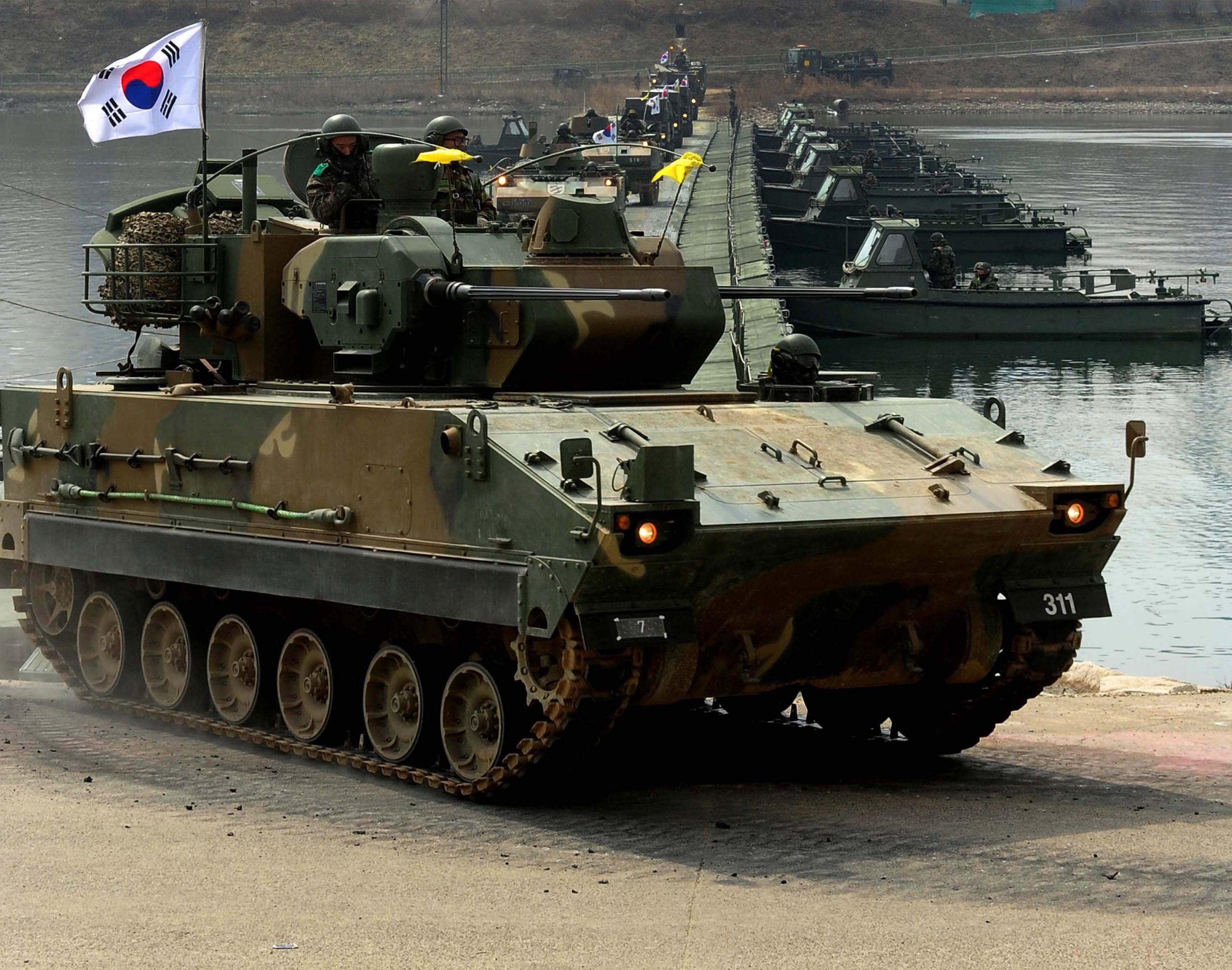
At the end of the 1990s the ROK started work on a next-generation IFV programme, with Doosan being awarded a contract to deliver a prototype Korea Next-Generation Infantry Fighting Vehicle (KNIFV) in 2003. After successful prototype testing, Doosan were awarded a production contract in 2009, for a first tranche of K21 vehicles for the ROK Army.
DHI and later Doosan also worked on wheeled 4×4 and 6×6 armoured vehicle solutions, with some limited success. The main prize in the wheeled armoured vehicle sector for ROK industry was an ROK military requirement for a large number of 6×6 and 8×8 vehicles. Three companies proposed solutions for the requirement, Doosan, Samsung Techwin and Hyundai Rotem, with the latter eventually selected to meet the requirement for some 600 vehicles. Despite this, the Doosan armoured vehicle business was a very credible capability and had a solid position in the ROK defence ecosystem.
The Growth Path
Over the years Hanwha has grown through substantial Mergers and Acquisition (M&A) activity and where required has spun off subsidiary companies that no longer meet its strategic vision. In 2014 Hanwha embarked on a wave of M&A activity that strengthened existing core areas in the company and also made plain that they had defined a new strategic area of interest for the company.
What made this particular M&A activity work was that Hanwha was looking to acquire capability, while Samsung was looking to divest capability in order to concentrate on its core electronics business and financial sector holdings. Petrochemicals have been a core business area of Hanwha for years, hence the attraction of acquiring Samsung General Chemicals and the Samsung stake in the Samsung-Total joint venture with Total of France. The other aspect of this M&A was that Hanwha had obviously decided that they wanted to become a major player in the defence sector and the means to achieve this goal was the acquisition of the defence, aerospace and security interests of Samsung.
This saw the Samsung interest in the Samsung-Thales joint venture acquired by Hanwha, providing radar, optronics, communications, command system and weapons capabilities. Then in 2016 Hanwha would acquire the Thales stake in the joint venture, making it a wholly-owned subsidiary. In the aerospace sector Hanwha gained aircraft and helicopter engine manufacturing, related component manufacturing capabilities, marine gas turbine manufacturing capabilities and missile motor technologies from Samsung. One of the most high-profile aspects of the M&A was the acquisition of Samsung Techwin, which amongst other things provided security and surveillance systems, as well as robotics technologies. Most importantly, it also gave Hanwha the self-propelled artillery capability developed by Samsung Techwin, which had obvious synergy with Hanwha’s existing artillery rocket business.
At the start of the 1980s in response to the continuing growth of the DPRK artillery threat, the ROK embarked on a programme to procure new self-propelled artillery. The aim was to produce the system locally and the M109A2 was selected to meet the requirement in late 1983, but in the end the turret and the ordnance were supplied from the US. Samsung Techwin were charged with producing the ROK M109A2 variant, as the K55, with over 1,000 systems being produced from 1985 until the late 1990s.

As the K55 entered production, the ADD started work on a programme to design and develop an indigenous advanced self-propelled artillery system. The objective was to field a 155 mm 52-calibre system, that had major growth potential to take into account advances in technology and changes in operational requirements. This resulted in the K9 Thunder system and in the development of supporting units in the form of the K10 ammunition resupply vehicle and the K77 fire direction centre vehicle. Subsequently, K9 technologies were applied to the upgrade of the K55 gun system, resulting in the K55A1, which is due to supplement the K9 in the ROK military until the K55A1 out-of-service date is reached.
The growth potential of the K9 was demonstrated by the fielding of the K9A1 variant in 2018, the next evolution is the K9A2, featuring reduced crew numbers and automatic loading, this will enter service in the near future. In the 2030s the K9A3 is due, set to be available in either manned or remote controlled configurations, and featuring a new L58 gun and extended range ammunition. Following this, in the 2040s another K9 system evolution is due to enter service.
Hanwha then added to its defence capabilities with another M&A programme in 2016 that saw the acquisition of Doosan’s armoured vehicle and related defence activities, which were formerly those of Daewoo. This put Hanwha into the top tier of ROK defence companies and helped it become a global defence company, principally via the sale of K9 systems in recent years to Australia, Egypt, Estonia, Finland and India. In August 2022 Hanwha signed a major contract with Poland, under which up to 672 K9 systems will be acquired, with some to be directly acquired from the ROK and some produced in Poland. October 2022 saw the signing of a contract under which Hanwha will supply Poland with 288 Chunmoo MRL systems, with the first 18 to be delivered in 2023. Hanwha will also supply a full range of rockets, with rocket production planned to eventually take place in Poland.
Elsewhere in Europe, Norway, which had previously acquired 24 K9 guns and six K10 ammunition resupply vehicles, added to its fleet with the purchase of four more K9 and eight more K10 systems in November 2022. Future prospects for the K9 in Europe include the Romanian self-propelled gun requirement and the British Army Mobile Fires Programme (MFP). Another important Hanwha programme is the AS21 Redback IFV, based upon the K21 IFV, it is one of the final two contenders selected for the Land 400 Phase 3 programme in Australia. It is also being offered by one of the groups competing for the US Army’s OMFV programme, and has been evaluated in Poland in connection with a ‘Heavy’ IFV requirement, ostensibly to supplement Polish Borsuk IFVs which are due to enter service by around 2024.
The Next Phase
The next phase in the future growth trajectory of Hanwha became clear in September 2022, when Hanwha signed a conditional purchase agreement with the Korea Development Bank (KDB) under which they would acquire a 49.3% share and management control of Daewoo Shipbuilding & Marine Engineering (DSME) in an arrangement valued at USD 1.53 Bn. Hyundai Heavy Industries (HHI), the main competitor of DSME, had attempted to buy the company earlier in 2022, but that effort failed in the face of competition concerns from the EU.

With DSME, Hanwha is gaining the third largest shipyard by value in the world, the downside is the current state of the operation. This is why Hanwha only signed a conditional purchase agreement, which enabled them to conduct proper due diligence of DSME in order to obtain a full idea of its assets and liabilities. According to media reports out of the ROK, Hanwha are now satisfied with what they have found at DSME and are set to proceed with the acquisition. However, they will have to seek regulatory approval from competition authorities in the ROK and internationally. Assuming that these approvals are received, Hanwha hopes to complete the acquisition and take full control in the first half of 2023.
DSME is a major commercial shipbuilder and has benefitted from increased demand for LNG tankers in recent times, it is also a major player in offshore platforms and rigs. Presumably more important for Hanwha is the naval business of DSME, responsible for the construction of submarines, destroyers and frigates. The primary customer is the ROK Navy, but there have been exports to Thailand, a submarine contract with Indonesia, which they hope to expand, and potential business in the Philippines. In addition, four replenishment tankers have been sold to the British Royal Fleet Auxiliary, Norway purchased a logistic support ship and Malaysia has purchased training vessels from DSME.
Hanwha will have to inject management resources and capital investment into DSME, which is currently a lossmaking business. On the other hand, if they can restore DSME to financial health they will have a very useful asset in their hands. For the future, it is clear that Hanwha intend to be a major international player in the defence sector, and have the resources to compete internationally.
David Saw




